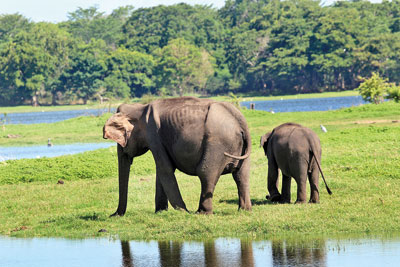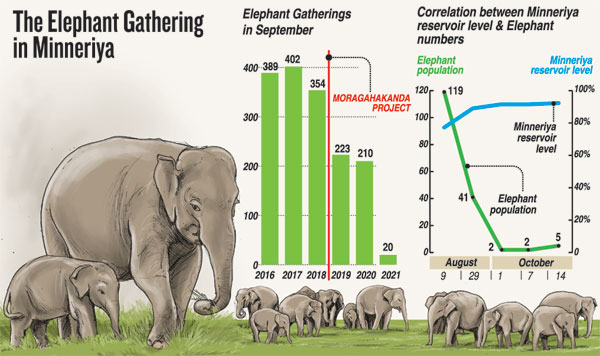News
‘Gathering’ shuns ‘brimming’ Minneriya

Then: The ‘Gathering’ of a large number at Minneriya in 2017 (before 2018 and the Moragahakanda Project). Now (inset): Very few elephants in September 2021. Pix by Dr. Sumith Pilapitiya
- Wild elephant numbers drop from 400 before Moragahakanda Project to 2 in early October this year
- If quick action is not taken Sri Lanka will kill wildlife wonder, lose millions from tourism & pave way for increased HEC
There were 400 wild elephants relishing the tender grass while the babies gambolled and the young bulls flexed their muscles in the not too distant past. Now there are 2!
This year, the ‘Great Elephant Gathering’ at Minneriya dubbed by Lonely Planet as “one of the 10 greatest wildlife wonders of the world”, is no more. Killed by irrational decisions and shortsighted policies.
“People vote but wild elephants don’t. This is the crux of the problem that is slowly and surely causing the death of the Great Elephant Gathering at Minneriya,” reiterates a deeply-worried former top wildlife conservation official.
There is no rhetoric, just facts and figures which are irrefutable, when the Sunday Times meets the former Director-General of Wildlife Conservation and avid elephant researcher, Dr. Sumith Pilapitiya this week.

Dr. Sumith Pilapitiya
Stressing that wild elephants do not have a voice in the scheme of things in Sri Lanka, he voices serious concern that the country would lose billions of precious dollars from tourism, for which the Great Elephant Gathering is a strong magnet.
Another matter causing migraines to conservationists including Dr. Pilapitiya is the upward trend in the human elephant conflict (HEC) in these areas. Where once, it was only the male elephants which turned into crop-raiders, this foolish decision may also be making female herds with babies to go into villages, as already evidenced.
“Tourism will flourish once the new normal of the pandemic is established, but cash-strapped Sri Lanka will lose out because of myopic and unscientific decisions which seem to be the order of the day,” says Dr. Pilapitiya, pulling out a notebook to give the facts and figures of the magnitude of the problem at Minneriya.
The Great Elephant Gathering is a natural phenomenon of the ‘coming together’ of a large number of wild elephants on the grasslands of the tank-bed of the Minneriya reservoir at the height of the dry season, between May and October.
The ‘highpoint’ is August and September when usually there are 350-400 elephants, says the former DG of Wildlife Conservation, explaining that these elephants are drawn to Minneriya not for the water but for the food in the form of the tender grassland. The water is an added boon.
Looking at nature, he says that during the rainy season from November to March, the tank-bed remains submerged. But with the release of the water collection for farming in March and April, the grassland emerges, until the monsoon starts once again in October and November.
“For decades, this phenomenon has occurred every year in this area, beckoning the wild elephants. They converge on Minneriya from about April to mid-October and then wend their way to Kaudulla where they lounge around from mid-October to early January and then find their way to the Hurulu Eco Park in January. This circle of life then repeats itself in April again,” says Dr. Pilapitiya.
 Underscoring that the grassland of Minneriya is essential to ensure the conservation future of this elephant population, he points out that the water-levels of Minneriya are directly co-related to the elephant numbers coming to the area.
Underscoring that the grassland of Minneriya is essential to ensure the conservation future of this elephant population, he points out that the water-levels of Minneriya are directly co-related to the elephant numbers coming to the area.
What changed?
Into this natural scene came ‘interference’ by humans in the form of the Moragahakanda Project and its ‘unseasonal’ release of water from Moragahakanda in June-July starting in 2018 and continuing in 2019, 2020 and 2021.
A warning of the imminent disaster was given by the Sunday Times on July 4, this year (2021) in an article headlined, ‘The Gathering is in peril’ along with a possible way out titled, ‘A simple hydraulic engineering solution’.
And now what the Sunday Times has warned has happened.
“There was a gradual water release to Minneriya from June and the tank was nearly-full in September and the elephants have not come,” laments Dr. Pilapitiya.
The Moragahakanda Project and ‘unseasonal’ water releases to Minneriya began every June-July since 2018. The amount of water released has increased each year because Minneriya has to be 70% full for water to spill into the Yoda Ela for onward transfer to Kantale and Kaudulla.
But at what cost, asks Dr. Pilapitiya. Talking economics, he says this could be the end of the Great Elephant Gathering of Asia unless the water level of the Minneriya tank is kept low in the dry season. The Gathering ‘floods’ Sri Lanka’s economy with a huge Rs. 4,000 million per year. Will any agricultural project receiving the additional water contribute even Rs. 100 million per year? So there is no “economic sense” in filling up Minneriya during the dry season.
He belabours the point that it would also drastically increase the HEC due to crop raiding by elephants which, in turn, would lead to agricultural losses rather than the small gains accrued by the project.
“Sri Lanka will lose tourism revenue and also agricultural revenue, while elephants and humans will die in an escalation of the HEC. It is an obvious ‘lose-lose situation’, so why are we doing this,” is Dr. Pilapitiya’s plaintive question.
| Elephants look for alternative food and HEC rises What happens to the Great Elephant Gathering due to the unseasonal release of water under the Moragahakanda Project? The unseasonal water releases have drastically cut down or restricted the dry season food source of these elephants by ‘flooding’ the tank-bed grassland, says Dr. Sumith Pilapitiya, pointing out that at this time because it is the dry season, the resources in the forests are also low. This is why the elephants usually congregate on the grasslands. “Now no grassland, low levels of food in the forests and so the elephants would naturally be forced to go look for ‘alternative sources’ of food,” he says. The ‘alternative sources’ of food are becoming obvious, according to Dr. Pilapitiya. Crop raiding, although risky, is one of these alternatives. Males follow this “high risk, high gain” strategy and now there have been instances of herds (mainly comprising females and their young of different ages) raiding crops in the Minneriya and Kaudulla areas, with at least three females being shot dead. Dr. Pilapitiya is quick to point out that there has been a “significant” rise in the human elephant conflict (HEC) in the areas around Minneriya and Kaudulla, with wild elephants being observed in densely-populated areas in Habarana. After the unseasonal release of water under the Moragahakanda Project, between 2018 and 2020, there has been a six-fold increase in the HEC in these areas, he says, adding that the elephants seem to be giving a wide berth to Minneriya. Even though there is little scientific data, by deduction we may assume that they may be expanding their range and going into areas they have not been visiting previously.
| |
| Link between ‘unseasonal’ water volume at Minneriya and drastic drop in elephant numbersThe ‘correlation’ or strong link between lots of water at Minneriya ‘unseasonally’ and the drastic drop in the magnificent numbers of the Great Elephant Gathering is beyond doubt. Dr. Sumith Pilapitiya says the water releases to Minneriya under the Moragahakanda Project this year (2021) had begun from June. The reservoir was close to the brim by September………and the elephants did not come. Kaudulla is simply mirroring the same disturbing situation as Minneriya. |


